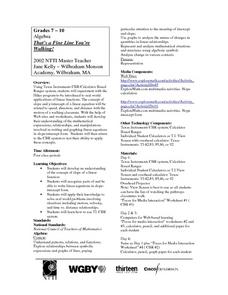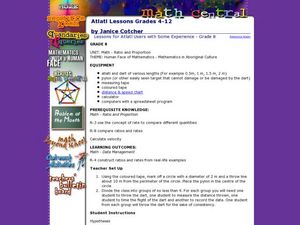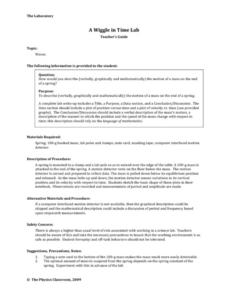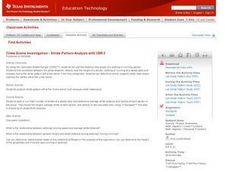Curated OER
Cannonball
Students calculate the speed, motion and distance of a projectile. In this geometry lesson, students obtain measurements while calculating velocity. They graph their results and make predictions.
Curated OER
Time Trials
Students investigate speed, time and distance. In this algebra instructional activity, students utilize their knowledge of linear equations to solve problems related to time, speed and distance. This assignment is hands on using two toy...
Curated OER
Impulse/Momentum Lab
Students investigate the relationship between force and momentum using motion detectors and sensors. In this physics lesson, students graph experimental results. They calculate impulse using the area under the graph.
Curated OER
That's a Fine Line You're Walking!
Students experiment with Hiker program to practice real world applications of linear functions and develop their understanding of expressions, relationships, and manipulations involved in writing and graphing linear equations in...
Curated OER
Atlatl Lessons for Grade 8
Eighth graders explore the weapons of the Aboriginal people. In this eight grade math/science lesson, 8th graders collect and analyze data regarding the speed and distance of a dart thrown with an atlatl. Students choose the...
Curated OER
Forces and Motion -- The Downhill Racer
Students examine the movement of a car on an inclined plane and on a flat surface. Using the amount of drops the car releases, they determine if it was traveling at a constant speed or not. They graph the velocity and acceleration rates...
Curated OER
Investigating Motion
Students determine velocity using the slope of a time distance graph. They investigate a motion cart using a CBR unit and a TI 83 calculator setup. Using the graph generated, they calculate velocity.
Curated OER
Worksheet #3, Derivative Rates, Percent Rate of Change, Chain Rule
In this calculus activity, students answer compute the distance of an object from a given point after t seconds when given the formula. They use the chain rule to answer 2 questions. Students compute the derivatives and sketch a graph of...
Curated OER
Newton's Second Law of Motion
Sixth graders study Newton's second law of motion and verify it. For this force and motion lesson students complete a lab activity and collect data, analyze it and graph it.
Curated OER
Numerical Determination of Drag Coefficients
Students create a video of an object falling with a drag. In this physics instructional activity, students calculate drag coefficient using data from Logger Pro. They calculate velocity and acceleration of the object.
Curated OER
Blowing in the Wind
Pupils identify and interpret maps, graphs, charts, tables and political cartoons. Students identify what a compass rose is and review its meaning in relation to standard directions. Pupils design their own weathervanes. Students pencil...
Curated OER
Investigating Newton's Second Law Of Motion
Students participate in a lesson that investigates Newton's Second Law of Motion. They conduct an experiment of observing balls that are rolled down a ramp. The lesson includes background information for the teacher for preparation and...
Flipping Physics
AP Physics 1: Kinematics Review
Test takers stressing out over the upcoming exam? Help them prepare for the AP Physics i exam with this fast-paced video that includes a complete guide to everything related to kinematics. Also included are some common errors and...
Physics Classroom
A Wiggle in Time Lab
Though an alternative method is suggested, the best way to carry out this investigation is with the use of a computer-interfaced motion detector. Physics fanatics hang a mass on the end of a spring and analyze its motion verbally,...
Texas Instruments
Vandalism 101
Learners explore logic and use Geometer’s Sketchpad and patterns of logic to solve a puzzle.
Curated OER
Braking Distance
This real-life model of braking distance motivates learners to approach quadratic equations algebraically, numerically, graphically, and descriptively.
Curated OER
Observation and Inference
Assess your young scientists' understanding of the difference between observation and inference with this 20-question multiple choice quiz. It reviews a variety of physics and astronomy concepts, such as solar eclipses and sunspots, the...
Alabama Learning Exchange
Energy and Work Amusement Park Style
Students distinguish between kinetic and potential energy. They recognize that energy can change from one form to other forms. They identify and describe several forms of energy.
Curated OER
The Universe
Students describe what scientists mean by an "expanding universe" in their own words. They explain how scientists comprehend the universie is expanding. Students comprehend the vast scale of the universe. They comprehend how theory...
Curated OER
Rocket Angles
Eighth graders create rockets that be launched at varying angles to determine which angle is best to launch at for the longest distance.
Alabama Learning Exchange
Cosmic Measurements
Students develop two units of measurement to relate to the astronomical unit and the light year. In this astronomy lesson, students use a Twizzler to develop a measurement unit similar to the astronomical unit. They use a moving object,...
Curated OER
Vectors
In this Algebra II activity, 11th graders find the sum of a pair of vectors. The two page activity contains a combination of nine multiple choice and free response questions. Answers are included.
Curated OER
Does Weight Affect Drag?
Learners investigate how weight affects a parachute's rate of fall. In this investigative lesson students test parachutes, average results and conclude what makes a faster descent.
Curated OER
Applied Fundamental Theorem of Calculus
Young scholars apply the Fundamental Theorem of Calculus. In this calculus instructional activity, students identify the graphical connections between functions and accumulation functions. They use a TI to represent the functions.
























